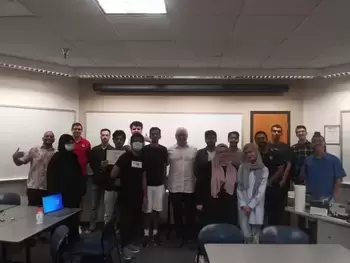 This summer, GreenLight Solutions had the pleasure of guiding students from King Abdullah University of Science and Technology (KAUST) through a GreenLight Bootcamp where they helped a brand new corporation, Alarivean. Alarivean shared some new technologies with these students, such as nanobubble oxidization and vessel mounted delivery systems. These technologies introduce concepts and practices of sustainability to local and foreign bodies of water. Alarivean recognized that the bodies of water in Saudi Arabia have been immensely harmed by human caused stressors. The new technology provided relief to the waters in order to continue their cycle of self-repair and environmental well-being. KAUST aims to have its students leave their mark on the world through research and experience and this group was able to do just that by essentially “speed-running” a typical GreenLight Solutions project. They went through all of the steps and outlines that every solutioneer works through but in a much shorter time frame. This included filling out a VMOSTT and creating a work plan. This time around there were three student projects each with different focus. Geographical Analysis Team one consisted of interdisciplinary students who focused on technical business development. They aimed to provide a solid framework of recommendations for where in the Persian Gulf Alarivean should deploy their vessels. The geographical analysis team made it their goal to research 3 different geographic areas, pinpoint 3 locations, and then identify 2 significant points of contact for each location. In order to accomplish this, the students had to take into account various factors about each location and general area. Including economic, social, and ecological risks. They also had to consider government support, the aquaculture of the local area, and more when choosing the location. The team successfully created a SWOT (strengths, weaknesses, opportunities, and threats) analysis document to provide Alarivean with all the information they promised and more in order to help them establish their final location for vessel deployment. To learn more about team one’s project take a look at their Project Portfolio. Boat Design Team two was made up of mechanical and electrical engineering students whose goal was to design an operational model. The operational model the team chose was a boat tasked with distributing nanobubbles at different depths. The team's goal was to purify the body of water it would be stationed in all while having the least negative impact on the surrounding waters’ health. The team aimed to provide a prototype layout sketch of the boat design including 60% of the intended boat equipment (solar panels and additional machines). As well as to provide a small framework of suggestions listing 2 pros and 2 cons for both energy and hydraulic systems. Not only was the team able to meet their goals but they exceeded them by including 100% of the boat’s equipment in the final layout and creating a full list of 2+ pros and cons of each system. Additionally, the team tackled other recommendations for the optimization of the Alarivean boats and helped to maximize the nanobubble operations. Check out the team’s Project Portfolio here! Bromine Sensor Evaluation The third team was composed of a group of students majoring in physics, biology, and mathematics. The students made it their goal to help develop a model that could detect dangerously high levels of algae in a body of water and then automatically distribute the correct amount of nanobubbles needed to reverse the problem. In order to accomplish this goal, the team needed to delve into current instruments being used to accomplish similar tasks such as bromine sensors and nanobubble dispersion processes. They then needed to put all of their findings into a recommendations report including the summarized costs for the optimization of bromine sensor technology that Alarivean could adopt. This group’s key progress indicator goals were to utilize the evaluation of equipment included in the NOAA results to identify and summarize 2 current instruments used to optimize the performance of nanobubble technologies. Ultimately, the team was able to accomplish these goals by providing specific and accurate information on existing tools used to measure bromine levels in water. While simultaneously creating a concise recommendation and conclusion for Alarivean to utilize. The full scope of the team’s work is found in their project portfolio! By the end of the bootcamp, the KAUST students were able to accomplish some very impressive work by using their ever-growing knowledge and experience. As well as wisely utilizing the resources provided to them by Alarivean. The teams were able to excel in this project due to suggestions made by Michael Corridan who co-founded Alarivean, advice from Kait Decker with ASU Global Launch, and feedback/guidance from GreenLight Solutions bootcamp facilitators. Written By: Yasmin Calderon Feliciano Yasmin Calderon Feliciano is a second-year student currently at Mesa Community College with plans to transfer to ASU to complete her BA in Sustainability. She has been with Greenlight Solutions as a solutioneer since Spring 2022 and hopes to continue working closely with them in the future.
0 Comments
Leave a Reply. |
Archives
July 2024
Categories |
|
RECEIVE GREENLIGHT NEWS
|
© GreenLight Solutions. All rights reserved.
|

 RSS Feed
RSS Feed